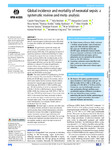Global incidence and mortality of neonatal sepsis: a systematic review and meta-analysis
Fleischmann, Carolin
Reichert, Felix
Cassini, Alessandro
Horner, Rosa
Harder, Thomas
Markwart, Robby
Tröndle, Marc
Savova, Yoanna
Kissoon, Niranjan
Schlattmann, Peter
Reinhart, Konrad
Allegranzi, Benedetta
Eckmanns, Tim
Background Neonates are at major risk of sepsis, but data on neonatal sepsis incidence are scarce. We aimed to assess the incidence and mortality of neonatal sepsis worldwide.
Methods We performed a systematic review and meta-analysis. 13 databases were searched for the period January 1979–May 2019, updating the search of a previous systematic review and extending it in order to increase data inputs from low-income and middle-income countries (LMICs). We included studies on the population-level neonatal sepsis incidence that used a clinical sepsis definition, such as the 2005 consensus definition, or relevant ICD codes. We performed a random-effects meta-analysis on neonatal sepsis incidence and mortality, stratified according to sepsis onset, birth weight, prematurity, study setting, WHO region and World Bank income level.
Results The search yielded 4737 publications, of which 26 were included. They accounted for 2 797 879 live births and 29 608 sepsis cases in 14 countries, most of which were middle-income countries. Random-effects estimator for neonatal sepsis incidence in the overall time frame was 2824 (95% CI 1892 to 4194) cases per 100 000 live births, of which an estimated 17.6% 9 (95% CI 10.3% to 28.6%) died. In the last decade (2009–2018), the incidence was 3930 (95% CI 1937 to 7812) per 100 000 live births based on four studies from LMICs. In the overall time frame, estimated incidence and mortality was higher in early-onset than late-onset neonatal sepsis cases. There was substantial between-study heterogeneity in all analyses. Studies were at moderate to high risk of bias.
Conclusion Neonatal sepsis is common and often fatal. Its incidence remains unknown in most countries and existing studies show marked heterogeneity, indicating the need to increase the number of epidemiological studies, harmonise neonatal sepsis definitions and improve the quality of research in this field. This can help to design and implement targeted interventions, which are urgently needed to reduce the high incidence of neonatal sepsis worldwide.
Files in this item

